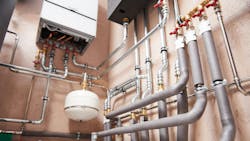Smart Water Recirculation: Boosting Efficiency and Safety in Buildings
Key Highlights
- Intelligent recirculation products improve tenant comfort by providing hot water faster and operate at lower flow rates to meet sustainability goals.
- Plug-and-play systems with real-time adjustments simplify installation and maintenance, offering multiple modes for optimized performance and energy savings.
- Water recirculation systems reduce Legionnaires' disease risks by ensuring continuous water flow and providing real-time monitoring and alerts for safety management.
- These systems support sustainability initiatives by lowering energy consumption, reducing emissions, and qualifying for government grants and funding programs.
- In industrial settings, intelligent recirculation minimizes water usage by up to 75%, maintains sanitary conditions, and automates cleaning processes to enhance efficiency and safety.
Professionals involved in commercial building HVAC upgrades increasingly choose intelligent recirculation products. These options can increase tenant comfort by providing hot water faster than conventional systems. They also align with sustainability goals due to operating at a comparatively lower flow rate.
Although setups vary depending on the brand and building layout, many recirculator components only run in cycles based on the building’s internal temperature. That reduces operating costs, making intelligent recirculation a wise investment after decision-makers budget for the initial expenses.
Plug-and-Play Systems Ease Installation
One company has released a plug-and-play advanced wet rotor electronic circulator for commercial heating and cooling systems, including those in hospitals, schools and offices.
Because it dynamically adjusts to real-time demands, this component helps users meet resource-savings goals. It prevents heating waste and maintains air conditioner stability, even if condensation forms on the outside. A dedicated 32-bit processor only uses energy when necessary. Building operators can also select from three modes to use the most efficient system performance curves.
One setting optimizes results by automatically adjusting the head according to system demand. People can also choose one that maintains a stable system pressure, enhancing balance and efficiency. Buildings that use constant-flow heating and air conditioning systems can opt for a fixed speed mode that generates a steady output. The circulator has an automatic sleep mode that activates every 25 hours for limescale buildup prevention. That feature promotes long-term reliability and extends the expected longevity.
Installers can rotate the head into three positions, giving them more flexibility when accommodating small spaces. Optional insulation shells also minimize heat loss and condensation, boosting thermal performance.
This product supports decision-makers interested in intelligent recirculation products who prioritize fast installation and numerous settings to address different needs. The circulator’s quick-connect power supply also simplifies the wiring requirements.
Property managers can also ensure reliable performance by putting this system inside an appropriate electrical enclosure. It protects sensitive components from environmental factors such as corrosion, snow, and ice buildup. The National Electrical Manufacturers Association established a rating system to indicate the performance and protection level of an enclosure. Selecting one according to the expected hazards is an easy and practical way to increase the return on investment for an intelligent recirculation system.
Water Recirculation Reduces Legionnaires’ Disease Risks
Although smart recirculation systems increase tenant comfort by providing hot water on demand, these options also reduce occupants’ likelihood of contracting Legionnaires’ disease. The associated bacteria thrive in tepid to warm water, particularly if the liquid does not circulate frequently and develops a biofilm.
Property managers associated with hospitals, nursing homes, or other commercial buildings populated by vulnerable groups must develop comprehensive plans to reduce the risks. An intelligent recirculation system is a useful component in a broader approach.
One company’s digital mixing valve features Internet of Things (IoT) technology that does more than control a facility’s water temperature. Designated parties also get real-time performance information and details about potable water conditions. Because the mixing station requires a minimum flow rate of 3-5 gallons per minute, a recirculation pump runs continuously, keeping stagnant liquid out of the water line. Installers can also insulate that component, resulting in negligible thermal energy losses.
An included intelligent water-management platform controls the temperature. It sends low-noise alerts to inform facility operators about overall performance and helps them diagnose potential issues more effectively.
Depending on the commercial building HVAC setup, property managers may enforce system purges if Legionnaires’ disease outbreaks occur. Most intelligent systems offer more proactiveness by flagging out-of-range readings and sending instant alerts. That information helps employees address the problem appropriately. Their actions minimize the chances of reputational damage, lawsuits and similar costs linked to extensive public health issues.
Smart Recirculation Systems Enhance Sustainability
Many property managers face increasing stakeholder pressures to make sustainable upgrades, which can reduce fossil fuel dependence, save money, and reduce wasted energy. Some decision-makers perform thorough building assessments to evaluate overall sustainability. That is a good starting point, and the results may encourage participants to invest in intelligent recirculation products or other upgrades.
In one example, the Washington State Department of Commerce provided 70 building owners with funding for energy-efficient upgrades that meet the state’s Clean Buildings Performance Standard (CBPS). An executive associated with the program mentioned numerous anticipated benefits, including creating jobs, reducing emissions and participating in a cleaner energy future. While 49 private building owners received this assistance, this program also awarded 21 public-sector grants.
The upgrades varied from lighting upgrades to smart building controls. The most relevant one to commercial building HVAC improvements occurred when the Pasco School District received almost $2 million to upgrade the hot water recirculation system and heat pumps. These changes will benefit a population of approximately 19,000 students and contribute to leaders’ long-term energy management plans.
Waste Reduction Supports the Bottom Line
Property executives are also interested in intelligent recirculation systems for commercial buildings because they curb excessive usage in industrial processes. One company’s system targets food and beverage plants that use fresh water for raw produce preparation. It supports process efficiency and repeatability as workers handle various root vegetables.
The system minimizes its active water flow and maintains an overall low volume, reducing the amount required to get the desired results. Processors consume up to 75% less because of this feature. The equipment also filters any debris from recirculating water and applies cleaned liquid, maintaining sanitary conditions while minimizing waste.
Because it has a fully automated, clean-in-place option, companies can uphold safety mandates without manual processes that often cause workers to waste water due to inexperience, distractions, or inadequate training.
The design also sends recirculated, cleaned water to the overall system instead of distributing it to separate destinations. This produces trustworthy results while helping users meet resource consumption goals. Intelligent recirculation for specific industries can become valuable when leaders know it will target known weaknesses. Food processors must use large amounts of water to clean consumables and equipment. This example shows they can continue meeting those standards while addressing waste.
Recirculation Systems Support Commercial Building HVAC Systems and More
Although many recirculation systems involve commercial HVAC upgrades, these options also enhance industrial processes that use massive amounts of water. Studying these real-world examples and viewing them in the context of a building’s needs can help officials determine when and how to make similar changes for measurable, beneficial results.
About the Author

Emily Newton
Emily Newton is an industrial and tech journalist passionate about how technology is revolutionizing each sector. She has been writing and editing professionally for more than five years and is the editor-in-chief of Revolutionized.
